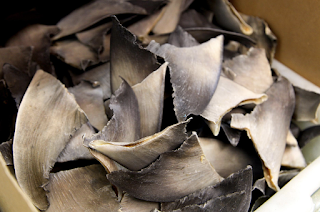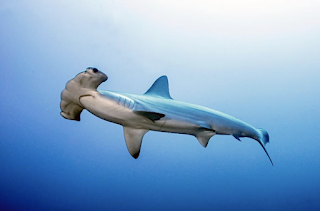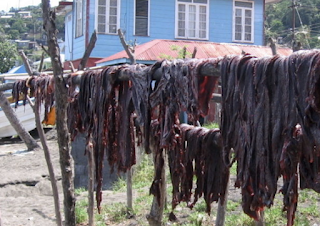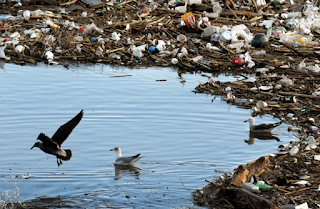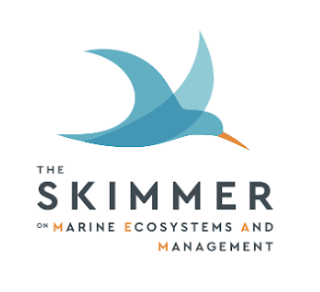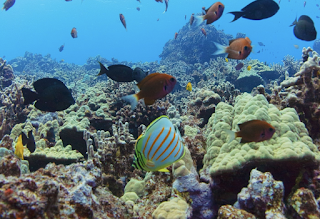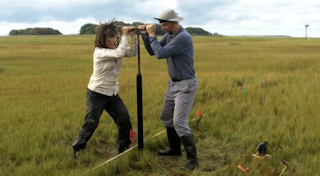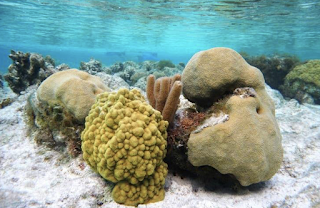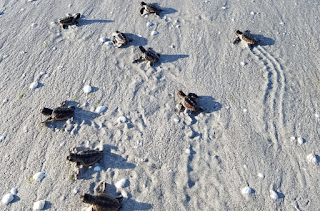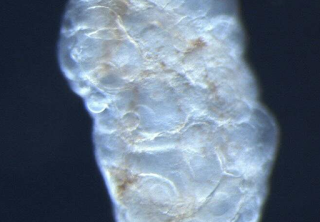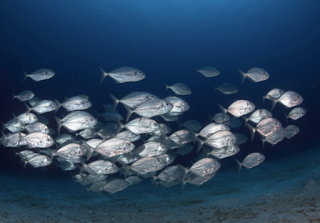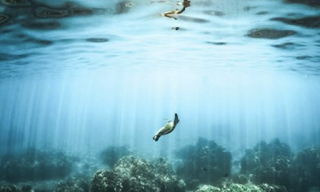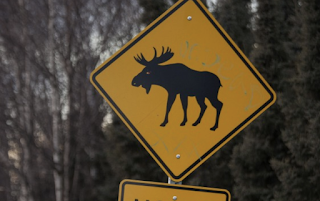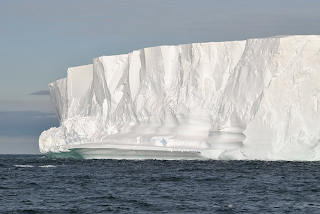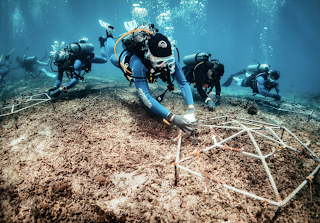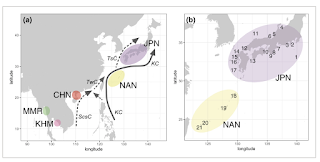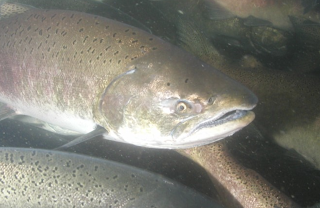Coronavirus triggers a wildlife import ban in China, US shark smuggling, Bottom line: how much will it cost to save oceans?, How zebrafish get their stripes, Sharks hold breath to stay warm, Ocean “bush meat” and more…
1. China bans trade of wild animals – Reaction to Coronavirus
 China’s wildlife-farming industry, valued at $74 billion, has been permanently shut down. On Monday, the nation’s legislature banned the buying, selling, and eating of wild animals in an effort to prevent zoonotic diseases from jumping from animals to people. The novel coronavirus, which has killed at least 2,700 people, is thought to have been transmitted to humans by pigs, civets, or pangolins at the Huanan Seafood Wholesale Market in Wuhan, China. “There has been a growing concern among people over the consumption of wild animals and the hidden dangers it brings to public health security since the novel coronavirus disease (COVID-19) outbreak,” Zhang Tiewei, a legislative spokesman, told Reuters Monday. Zhang added that the decision came at a “critical moment for epidemic prevention and control.”
China’s wildlife-farming industry, valued at $74 billion, has been permanently shut down. On Monday, the nation’s legislature banned the buying, selling, and eating of wild animals in an effort to prevent zoonotic diseases from jumping from animals to people. The novel coronavirus, which has killed at least 2,700 people, is thought to have been transmitted to humans by pigs, civets, or pangolins at the Huanan Seafood Wholesale Market in Wuhan, China. “There has been a growing concern among people over the consumption of wild animals and the hidden dangers it brings to public health security since the novel coronavirus disease (COVID-19) outbreak,” Zhang Tiewei, a legislative spokesman, told Reuters Monday. Zhang added that the decision came at a “critical moment for epidemic prevention and control.”
Editorial Comment: This law may not include sharks and other marines species
2. How the U.S. is inadvertently facilitating shark fin smuggling
3. What will it cost to save oceans?
In 2015, 193 countries agreed on 17 global objectives for ending poverty and protecting the environment by 2030. These Sustainable Development Goals (SDGs) included SDG 14, to “conserve and sustainably use the oceans, seas and marine resources for sustainable development.” A new study by two former diplomats with the CONOW Competence Centre for International Relations published in the journal Marine Policy estimates that to hit the targets needed to achieve this SDG the world must spend $175 billion per year.
Read more from “GreenBiz”
and
Can a shark hold their breath if it doesn’t have lungs like us? Yes, and it turns out that skill may be a superpower that helps some hammerheads hunt in cold, deep waters. The scalloped hammerhead Sphyrna lewini is a coastal and semioceanic shark in the family Sphyrnidae. Found around the globe in coastal warm temperate and tropical seas, they have been observed from the ocean’s surface and intertidal waters to at least 902 feet (275 meters) deep. Although it is wide-ranging species, there is genetic evidence for multiple subpopulations, and the species as a whole has been assessed as Endangered (EN) by the IUCN Red List of Threatened Species. All life-stages of this shark are vulnerable to capture as both target and bycatch in fisheries, their fins highly valued over other species because of their high fin ray count.
Scientists and conservationists have long expressed concern about the consumption of bushmeat, mindful of its impact on wildlife and human health. Yet the marine equivalent has received relatively little attention, even as dwindling resources have led more small-scale fishers in places such as West Africa to target dolphins, sea turtles and other mammals, reptiles and birds considered “aquatic wild meat.”
Today, Earth Island Institute and Plastic Pollution Coalition, represented by Cotchett, Pitre, & McCarthy, filed the first major lawsuit against Crystal Geyser Water Company, The Clorox Company, The Coca-Cola Company, Pepsico, Inc., Nestlé USA, Inc., Mars, Incorporated, Danone North America, Mondelez International, Inc., Colgate-Palmolive Company, and The Procter & Gamble Company for polluting our waterways, coasts, and oceans with millions of tons of plastic packaging. The lawsuit was filed in California State Superior Court in the County of San Mateo alleging violations of the California Consumers Legal Remedies Act, public nuisance, breach of express warranty, defective product liability, negligence, and failure to warn of the harms caused by their plastic packaging.
Read more from “Plastic Pollution Coalition”
Read more from “Los Angeles Times”
The United States has stood still as the European Union, Thailand, China and numerous other countries put in place national policies to address the growing plastics crisis threatening our oceans. Finally, the U.S. is poised to take an important step, thanks to the introduction of groundbreaking federal legislation. Last month, Sen. Tom Udall (D-N.M.) and Rep. Alan Lowenthal (D-Calif.) announced the Break Free From Plastic Pollution Act of 2020 (S. 3263 and H.R. 5845), first-of-its-kind legislation that curbs plastic production and holds plastic producers responsible for the waste they create.
What is ecological grief? As professionals in the marine conservation and management field, Skimmer readers are hyperaware of large scale and global changes to marine ecosystems – changes including loss of biodiversity, top predators, iconic species, and biomass and the degradation of habitats. These changes are due to climate change, overfishing, coastal development, and other human activities. New research is now examining the emotional and psychological toll that these changes are having on people.
9. Paleontologists discover why the oceans are so diverse
A new study has given insight into why the world’s oceans are full of more species than ever before – a question that has long been a focus of paleontological research. The most diverse kinds of animals in the modern oceans, such as fish, mollusks, and crustaceans, diversified slowly and steadily for long periods of time and were buffered against extinction. Andrew Bush, an author on the paper and associate professor of Geosciences and Ecology & Evolutionary Biology in the College of Liberal Arts and Sciences, says that knowing how biodiversity evolved over Earth’s history can help humans think about future issues with environmental disruptions, like climate change.
10. Containing methane and its contribution to global warming
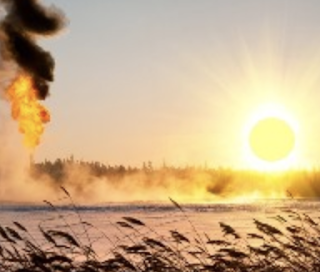 Methane is a gas that deserves more attention in the climate debate as it contributes to almost half of human-made global warming in the short-term. A new IIASA study shows that it is possible to significantly contribute to reduced global warming through the implementation of available technology that limits methane release to the atmosphere. According to the study published in the journal Environmental Research Communications, it is possible to achieve reduced global warming in the near term by targeting methane through the fast implementation of technology to prevent its release to the atmosphere. This could mitigate some of the otherwise very costly impacts of climate change that are expected over the next few decades. To achieve the significant reductions in methane emissions caused by humans needed to meet the Paris Agreement, we, however, need to know exactly where and from what sources emissions are emitted so that policymakers can start developing strategies to contain methane and its contribution to global warming.
Methane is a gas that deserves more attention in the climate debate as it contributes to almost half of human-made global warming in the short-term. A new IIASA study shows that it is possible to significantly contribute to reduced global warming through the implementation of available technology that limits methane release to the atmosphere. According to the study published in the journal Environmental Research Communications, it is possible to achieve reduced global warming in the near term by targeting methane through the fast implementation of technology to prevent its release to the atmosphere. This could mitigate some of the otherwise very costly impacts of climate change that are expected over the next few decades. To achieve the significant reductions in methane emissions caused by humans needed to meet the Paris Agreement, we, however, need to know exactly where and from what sources emissions are emitted so that policymakers can start developing strategies to contain methane and its contribution to global warming.
11. How do zebrafish get their stripes? New data analysis tool could provide an answer
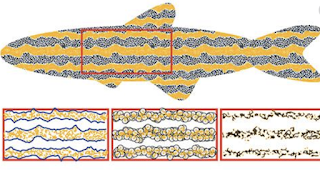 The iconic stripes of zebrafish are a classic example of natural self-organization. As zebrafish embryos develop, three types of pigment cells move around the skin, eventually jostling into positions that form body-length yellow and blue stripes. Scientists want to understand the genetic rules that direct this delicate dance, and a new algorithm developed by Brown University mathematicians could help them accomplish that. The algorithm, described this week in Proceedings of the National Academy of Sciences, is able to quantify various attributes of shapes and patterns, enabling scientists to more objectively test ideas about how zebrafish stripes — and potentially other developmental patterns — are formed.
The iconic stripes of zebrafish are a classic example of natural self-organization. As zebrafish embryos develop, three types of pigment cells move around the skin, eventually jostling into positions that form body-length yellow and blue stripes. Scientists want to understand the genetic rules that direct this delicate dance, and a new algorithm developed by Brown University mathematicians could help them accomplish that. The algorithm, described this week in Proceedings of the National Academy of Sciences, is able to quantify various attributes of shapes and patterns, enabling scientists to more objectively test ideas about how zebrafish stripes — and potentially other developmental patterns — are formed.
12. Deep-sea coral gardens and graveyards discovered in the submarine canyons off South Western Australia
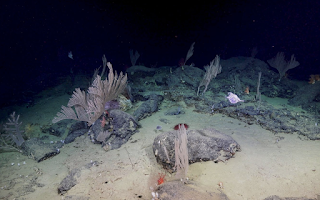 Stunning ‘gardens’ of deep-sea corals have been discovered in the Bremer Canyon Marine Park by Australian and international scientists during an oceanographic expedition aboard Schmidt Ocean Institute’s R/V Falkor. Bremer Canyon Marine Park is already known as a biodiversity hotspot for marine species such as whales and dolphins, however, a recent expedition focused on the deep sea has now revealed rich and diverse ecosystems inhabiting the cold waters deep within the canyon. Led by researchers from the University of Western Australia (UWA), these discoveries were only made possible by the philanthropic Schmidt Ocean Institute’s (SOI) deep-sea remotely operated vehicle, SuBastian, which is capable of sampling depths to 4,500 meters.
Stunning ‘gardens’ of deep-sea corals have been discovered in the Bremer Canyon Marine Park by Australian and international scientists during an oceanographic expedition aboard Schmidt Ocean Institute’s R/V Falkor. Bremer Canyon Marine Park is already known as a biodiversity hotspot for marine species such as whales and dolphins, however, a recent expedition focused on the deep sea has now revealed rich and diverse ecosystems inhabiting the cold waters deep within the canyon. Led by researchers from the University of Western Australia (UWA), these discoveries were only made possible by the philanthropic Schmidt Ocean Institute’s (SOI) deep-sea remotely operated vehicle, SuBastian, which is capable of sampling depths to 4,500 meters.
13. Is there a technological solution to aquatic dead zones?
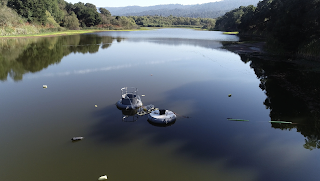 Could pumping oxygen-rich surface water into the depths of lakes, estuaries, and coastal ocean waters help ameliorate dangerous dead zones? New work led by Carnegie’s David Koweek and Ken Caldeira and published open access by Science of the Total Environment says yes, although they caution that further research would be needed to understand any possible side effects before implementing such an approach. When excessive nutrients from agriculture and other human activities wash into waterways, it can create a dangerous phenomenon called eutrophication. This can lead to low-oxygen dead zones called hypoxia.
Could pumping oxygen-rich surface water into the depths of lakes, estuaries, and coastal ocean waters help ameliorate dangerous dead zones? New work led by Carnegie’s David Koweek and Ken Caldeira and published open access by Science of the Total Environment says yes, although they caution that further research would be needed to understand any possible side effects before implementing such an approach. When excessive nutrients from agriculture and other human activities wash into waterways, it can create a dangerous phenomenon called eutrophication. This can lead to low-oxygen dead zones called hypoxia.
14. Scientists discover rapid sea-level rise along the Atlantic coast of North America 300 years ago
Sea levels along a stretch of the Atlantic coast of North America in the 18th Century were rising almost as fast as in the 20th Century, a new study has revealed. The study, led by the University of York, found evidence for a period of enhanced pre-industrial sea-level rise of about two to three millimeters per year in three locations: Nova Scotia, Maine, and Connecticut. The researchers say that the large rises at these three locations were natural and partly related to the North Atlantic Oscillation – a large-scale atmospheric pressure see-saw over the North Atlantic region – and to periods of enhanced ice melt in the Arctic.
15. Coral reefs in Turks and Caicos Islands resist global bleaching event
A study that relied on citizen scientists to monitor the health of corals on Turks and Caicos Islands in the Caribbean from 2012 to 2018 found that 35 key coral species remained resilient during a 2014-17 global coral-bleaching event that harmed coral reefs around the world. Even corals that experienced bleaching quickly recovered, the researchers found. Some corals appeared healthier in 2017 than they were in 2014. Coral bleaching is a common response to extreme heat stress, and global coral-bleaching events are becoming more frequent as the oceans warm. The 2014-17 bleaching event occurred as record-breaking sea-surface temperatures pushed some corals past their physiological limits.
Like most other species, male sea turtles will mate with any female sea turtle they can. However, when it comes to female sea turtles and mate selection, it’s a little more complex. Sea turtles are known to have multiple mates, yet there is no consensus on why they do. It is believed that female sea turtles may mate multiply to ensure fertilization, which will result in multiple paternity within their nests, providing “fertilization insurance,” so to speak. However, researchers from Florida Atlantic University suggest that this fertilization insurance hypothesis might not be so compelling after all.
In animals, releasing eggs in a timely manner is vital to maximizing the chances of successful fertilization. However, how this process evolved and is controlled in different species is poorly understood. A new regulator of egg release has been identified in jellyfish in a new study published March 3 in the open-access journal PLOS Biology by Gonzalo Quiroga Artigas and Evelyn Houliston of Sorbonne University, France, and colleagues. The finding sheds light on how the complex hormonal control of sexual reproduction in animals evolved.
An international team of researchers has revealed the mechanisms behind fish schooling – and what they found differs from what scientists had previously thought. Fish school by copying each other and changing directions randomly, rather than calculating and adapting to an average direction of the group, a group of scientists co-led by UNSW has shown. In the study, the researchers present the first experimental evidence of noise-induced ordering, which previously only existed as a theoretical possibility. The interdisciplinary team of ecologists, physicists and mathematicians achieved this by combining the capabilities of their scientific disciplines to integrate experiments with computer simulations and analysis.
19. Non-oxygen breathing animal discovered
20. Indian Ocean dolphin population plummets due to commercial fishing
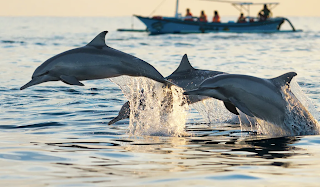
Fishing operations in the Indian Ocean have decimated dolphin populations over the last 70 years, according to a new study published in the journal Endangered Species Research. The fishing operations that have had dolphins swept up as bycatch have meant that nearly 4 million dolphins have died since 1950 and the population of dolphins in the Indian Ocean has declined by nearly 80 percent, as The Guardian reported. Those numbers just represent the dolphins killed directly as bycatch of drifting nets that trail behind large fishing boats and do not represent the number of dolphins, porpoises or whales killed by floating ghost nets, harpoons, other types of tuna fishing or animals that are injured and succumb to their wounds later. That means the actual number of dolphins killed from commercial fishing may actually be much higher, according to the study.
The U.S. Fish and Wildlife Service is failing to decide whether to protect 241 plants and animals under the Endangered Species Act, an environmental group says in a new lawsuit filed in a Washington federal court. The agency, under the Trump administration, allegedly hasn’t made findings on petitions to list 231 species as endangered or threatened. It also hasn’t published final determinations for six species nor finalized critical habitat for four species, according to the lawsuit filed by the Center for Biological Diversity Thursday in the U.S. District Court for the District of Columbia.
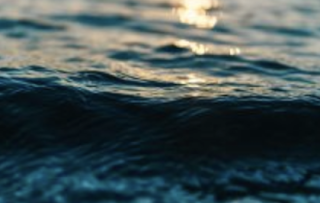 Chemical changes in the oceans more than 800 million years ago almost destroyed the oxygen-rich atmosphere that paved the way for complex life on Earth, new research suggests. Then, as now, the planet had an “oxidizing” atmosphere, driven by phytoplankton – the “plants” of the ocean – releasing oxygen during photosynthesis. However, new research from an international team including the University of Exeter and spanning Toulouse, Leeds, London, and Nanjing, suggests ocean changes in the early Neoproterozoic era (from one billion to 800 million years ago) may have locked away phosphorus – a vital nutrient for life-limiting phytoplankton growth and oxygen release.
Chemical changes in the oceans more than 800 million years ago almost destroyed the oxygen-rich atmosphere that paved the way for complex life on Earth, new research suggests. Then, as now, the planet had an “oxidizing” atmosphere, driven by phytoplankton – the “plants” of the ocean – releasing oxygen during photosynthesis. However, new research from an international team including the University of Exeter and spanning Toulouse, Leeds, London, and Nanjing, suggests ocean changes in the early Neoproterozoic era (from one billion to 800 million years ago) may have locked away phosphorus – a vital nutrient for life-limiting phytoplankton growth and oxygen release.
Inland Antarctic ice contains volumes of water that can raise global sea levels by several meters. A new study published in the journal Nature shows that glacier ice walls are vital for the climate, as they prevent rising ocean temperatures and melting glacier ice. The ocean can store much more heat than the atmosphere. The deep-sea around Antarctica stores thermal energy that is the equivalent of heating the air above the continent by 400 degrees. Now, a Swedish-led international research group has explored the physics behind the ocean currents close to the floating glaciers that surround the Antarctic coast.
 The Earth of 3.2 billion years ago was a “water world” of submerged continents, geologists say after analyzing oxygen isotope data from ancient ocean crust that’s now exposed on land in Australia. And that could have major implications on the origin of life. “An early Earth without emergent continents may have resembled a ‘water world,’ providing an important environmental constraint on the origin and evolution of life on Earth as well as its possible existence elsewhere,” geologists Benjamin Johnson and Boswell Wing wrote in a paper just published online by the journal Nature Geoscience.
The Earth of 3.2 billion years ago was a “water world” of submerged continents, geologists say after analyzing oxygen isotope data from ancient ocean crust that’s now exposed on land in Australia. And that could have major implications on the origin of life. “An early Earth without emergent continents may have resembled a ‘water world,’ providing an important environmental constraint on the origin and evolution of life on Earth as well as its possible existence elsewhere,” geologists Benjamin Johnson and Boswell Wing wrote in a paper just published online by the journal Nature Geoscience.
25. Dominican Republic: first in Caribbean to use map technology for coastal marine habitats
Several entities managed to enhance the conservation of coral reefs in the Dominican Republic by using cutting-edge technology to develop maps that allow visualization of coastal marine habitats. These are The Nature Conservancy (TNC) environmental conservation organization and the Global Airborne Observatory (GAO), in collaboration with Fundación Grupo Puntacana (FGPC), the Dominican Foundation for Marine Studies ( Fundemar ) and the Dominican Reef Network (RAD ), who presented the new maps, composed of high-resolution images and three-dimensional models of the seafloor.
 The Lakshadweep Islands administration has announced the creation of the world’s first conservation area — 239 sq. km — for endangered sea cucumbers. The announcement came after reports of smuggling of sea cucumbers and other vulnerable marine species for sale in east Asia. Hindustan Times has been reporting about the illegal trade. Sea cucumbers are invertebrates ranging in sizes up to six feet (1.8m). The species is high in demand across south-east Asia, mainly China, for food and traditional medicine. In India, the species is listed under Schedule I of the Wildlife Protection Act (WPA), 1972, akin to the protection for a tiger, leopard or elephant.
The Lakshadweep Islands administration has announced the creation of the world’s first conservation area — 239 sq. km — for endangered sea cucumbers. The announcement came after reports of smuggling of sea cucumbers and other vulnerable marine species for sale in east Asia. Hindustan Times has been reporting about the illegal trade. Sea cucumbers are invertebrates ranging in sizes up to six feet (1.8m). The species is high in demand across south-east Asia, mainly China, for food and traditional medicine. In India, the species is listed under Schedule I of the Wildlife Protection Act (WPA), 1972, akin to the protection for a tiger, leopard or elephant.
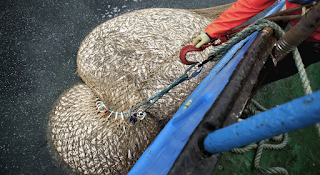 The need to protect the ocean has never been more urgent, and as new decade dawn, governments around the world are recognizing this. Many are uniting around a resolution—first agreed to at the 2016 World Conservation Congress—to protect at least 30 percent of the ocean within marine protected areas (MPAs) or through other effective conservation measures (OECMs) by 2030.
The need to protect the ocean has never been more urgent, and as new decade dawn, governments around the world are recognizing this. Many are uniting around a resolution—first agreed to at the 2016 World Conservation Congress—to protect at least 30 percent of the ocean within marine protected areas (MPAs) or through other effective conservation measures (OECMs) by 2030.
Since the late 19th century, pearl aquaculture has been a revered industry in Japan, enabling widespread cultivation and commercialization of beautiful pearls. From a genetic and evolutionary perspective, scientists have known little about the source of these pearls — the Japanese pearl oyster, Pinctada fucata — until now.
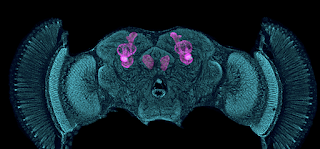 New research shows that crustaceans such as shrimps, lobsters, and crabs have more in common with their insect relatives than previously thought – when it comes to the structure of their brains. Both insects and crustaceans possess mushroom-shaped brain structures known in insects to be required for learning, memory and possibly negotiating complex, three-dimensional environments, according to the study, led by the University of Arizona neuroscientist Nicholas Strausfeld. The research, published in the open-access journal eLife, challenges a widely held belief in the scientific community that these brain structures – called “mushroom bodies” – are conspicuously absent from crustacean brains.
New research shows that crustaceans such as shrimps, lobsters, and crabs have more in common with their insect relatives than previously thought – when it comes to the structure of their brains. Both insects and crustaceans possess mushroom-shaped brain structures known in insects to be required for learning, memory and possibly negotiating complex, three-dimensional environments, according to the study, led by the University of Arizona neuroscientist Nicholas Strausfeld. The research, published in the open-access journal eLife, challenges a widely held belief in the scientific community that these brain structures – called “mushroom bodies” – are conspicuously absent from crustacean brains.
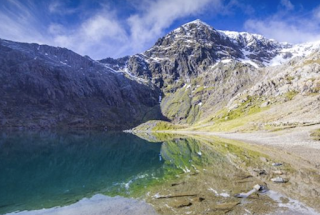 The discovery of microplastic pollution near the top of the highest mountain in Wales is a “scary wake-up call”, environmentalists have said. Traces of plastic have been found in samples collected from Llyn Glaslyn – a remote lake near the summit of Snowdon. The tiny particles are “most likely” to have been deposited by rain, wetland science expert Dr. Christian Dunn said. A swimmer who gathered the samples will now visit all the UK’s 15 national parks to learn more. Activist Laura Sanderson swam 16 miles (26km) from the source of River Glaslyn – 2,000ft (610m) above sea level – to the sea, last April, collecting water samples along the way.
The discovery of microplastic pollution near the top of the highest mountain in Wales is a “scary wake-up call”, environmentalists have said. Traces of plastic have been found in samples collected from Llyn Glaslyn – a remote lake near the summit of Snowdon. The tiny particles are “most likely” to have been deposited by rain, wetland science expert Dr. Christian Dunn said. A swimmer who gathered the samples will now visit all the UK’s 15 national parks to learn more. Activist Laura Sanderson swam 16 miles (26km) from the source of River Glaslyn – 2,000ft (610m) above sea level – to the sea, last April, collecting water samples along the way.
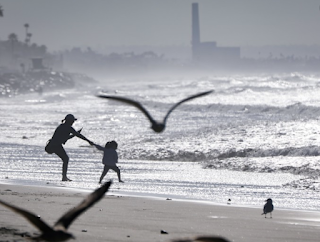 A new ocean protection plan sets out steps to safeguard California’s coast against rising seas while shoring up public access and building coastal economies. The Ocean Protection Council on Wednesday approved the Strategic Plan to Protect California’s Oceans, a five-year roadmap for navigating threats including climate change, pollution, and loss of biodiversity. The council, a policy body within the California Natural Resources Agency, wanted to distinguish the new plan from previous editions, by focusing on specific timelines and funding sources.
A new ocean protection plan sets out steps to safeguard California’s coast against rising seas while shoring up public access and building coastal economies. The Ocean Protection Council on Wednesday approved the Strategic Plan to Protect California’s Oceans, a five-year roadmap for navigating threats including climate change, pollution, and loss of biodiversity. The council, a policy body within the California Natural Resources Agency, wanted to distinguish the new plan from previous editions, by focusing on specific timelines and funding sources.
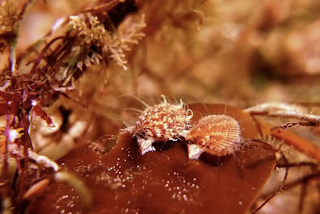 After the government allowed trawlers to come closer to Scottish shores in 1984, the marine ecosystem around the Isle of Arran steadily collapsed, as bottom-trawlers and dredgers intensively combed the seabed with their vibrating spikes. Now, more than 30 years later and following the interventions of local residents, there has been a dramatic revival in species of mollusks and finfish. A “no-take zone” implemented here in 2008 – after a community-based campaign to lobby the Scottish government – has been a huge success, according to a new report that shows a substantial increase in biodiversity.
After the government allowed trawlers to come closer to Scottish shores in 1984, the marine ecosystem around the Isle of Arran steadily collapsed, as bottom-trawlers and dredgers intensively combed the seabed with their vibrating spikes. Now, more than 30 years later and following the interventions of local residents, there has been a dramatic revival in species of mollusks and finfish. A “no-take zone” implemented here in 2008 – after a community-based campaign to lobby the Scottish government – has been a huge success, according to a new report that shows a substantial increase in biodiversity.
At the annual Ocean Salmon Informational Meeting held in Santa Rosa today, state and federal fishery scientists presented updates on the numbers of California’s spawning salmon, as well as the expected abundance for the upcoming fishing season. The 2020 ocean abundance projection for Sacramento River fall Chinook (SRFC), the main salmon stock harvested in California waters, is estimated at 473,200 adult salmon, higher than the 2019 forecasts. The Klamath River fall Chinook (KRFC) abundance forecast of 186,600 adult salmon is lower than the 2019 forecast and will likely result in reduced fishing opportunity in the areas north of Pt. Arena.
———————————————–

